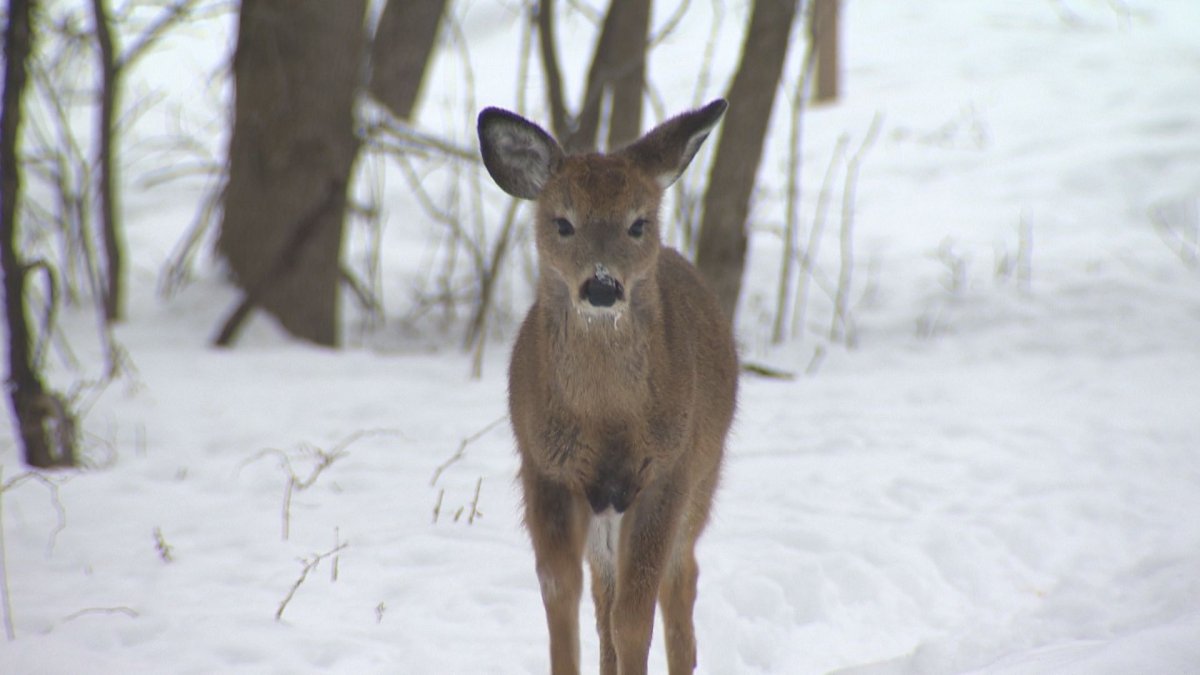White-tailed deer have flourished in Quebec in recent years, leaving governments and biologists struggling to find ways to control their numbers amid vocal opposition to mass culls.

After the City of Longueuil, Que., it’s the turn of Quebec’s provincial parks society to announce it needs to cut the number of deer in two provincial parks near Montreal by at least 200 animals due to overpopulation.
While it has yet to elaborate a plan to reduce the herd, the parks society noted that experts and scientists have strongly recommended using a “lethal method.”
“The significant impacts of overpopulation have been documented, not only on ecosystems, but also on public health and the livestock themselves: environmental degradation due to excessive grazing, scarcity of food for all species, increased risks of Lyme disease spread and traffic collisions, among others,” the Société des établissements de plein air du Québec wrote in an email.
The government estimates the number of deer in Quebec at 250,000, largely concentrated in the south of the province, where densities in some places can reach 15 animals per square kilometre — three times what’s considered “optimal,” the Wildlife Department said in an email.
Jean Fink, a biologist who has studied the white-tailed deer, said there are several reasons the animals become too numerous in some places. The biggest reason, he said, is warmer winters.
A tough, snowy winter can wipe out about 40 per cent of a herd through starvation, he said in an interview. But the milder winters of recent years, combined with a deer’s high reproduction rate, has allowed their numbers to surge.
He said the highest densities, and biggest problems, are found in protected areas and parks near big cities such as Montreal and Gatineau, where there are few natural predators such as coyotes and wolves, and where hunting isn’t allowed.
“In the absence of hunting, when there are good winters and food is abundant, well, they invade municipalities’ territory and find places where there’s cover to protect them from the snow,” he said.
“Some people even feed them.”
Carolyn Callaghan, a conservation biologist with the Canadian Wildlife Federation, says deer are an adaptable species that have thrived in areas close to cities, while their predators have not.
However, excessive grazing kills trees and shrubs and causes “cascading impacts” on all the other species that depend on the vegetation, she said, such as insects and birds.
The City of Longueuil, on Montreal’s south shore, announced in 2020 that it would kill most of the deer in a local park, but it was forced to relent after a strong public backlash that included threats against the former mayor. But last year, the city revived the plan after a committee rejected other options, including relocating the deer or reducing their numbers with sterilization.

Callaghan says that while sterilizing animals has been done successfully in some species such as wolves, it would be harder to do with deer, which have a high number of breeding females. It would also be very costly, she said.
In an email, the Quebec Wildlife Department says it recommends “controlled hunting” as its preferred way to bring down deer populations. However, the department noted that hunting is not possible in some areas such as Longueuil, which cannot easily be closed off to the public.
Both Callaghan and Fink said that sport hunters are a part of the solution in the absence of natural predators. While hunting may not be possible in all urban parks, an increased hunting quota in surrounding areas could help keep the overall numbers down, they say.
Fink says the other option is to allow the deer to live naturally and accept the changes they bring to the habitat. However, he said this solution would eventually condemn the animals to a more painful death by starvation and could also result in them migrating further into urban areas in search of food, raising the risk of car accidents.
Callaghan said that while culling in the short term might be inevitable, in the long term it might be possible to find more “holistic” solutions that would help the populations in some areas to stabilize naturally. That could include ensuring that predator species aren’t hunted and creating wildlife corridors to allow them to reach their prey, she said.
In the meantime, she added, governments and scientists will have to make some decisions that might be unpopular with the public.
“A lot of people have a great love for every single deer that’s out there and they don’t want to see them harmed, I do understand that,” she said.
“But at a certain point, we have to step back and take a little bit of a broader view and ecosystem view, which is going to cover the needs of the thousands of other species that can exist in these ecosystems.”



Comments